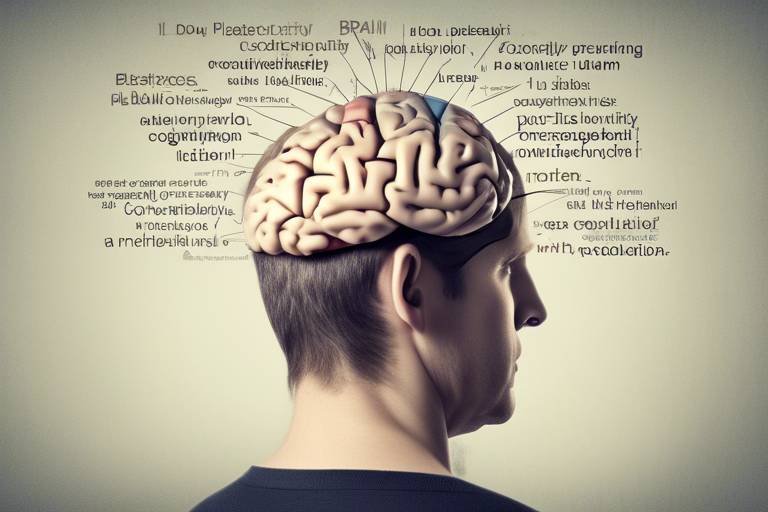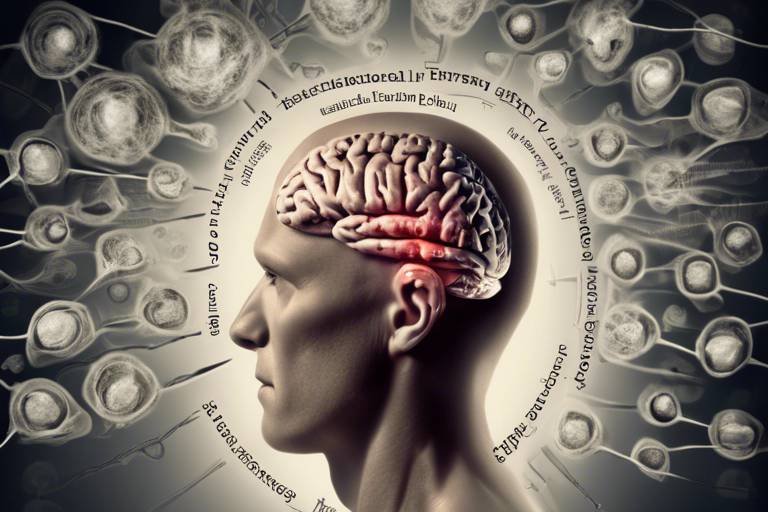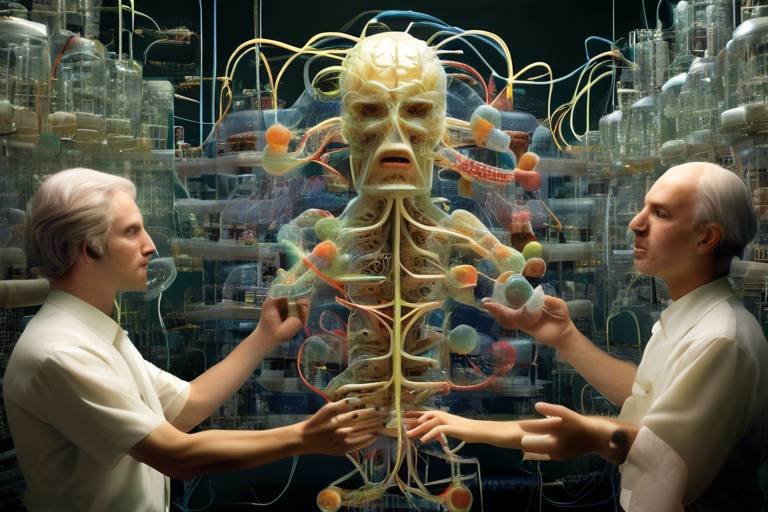Brain Plasticity - The Philosophy Underpinning Cognitive Rehabilitation
Have you ever wondered how some people manage to recover from severe brain injuries while others struggle? The answer often lies in a fascinating concept known as brain plasticity. This remarkable ability of the brain to rewire itself and form new neural connections is not just a scientific curiosity; it’s a fundamental principle that underpins cognitive rehabilitation. Understanding brain plasticity can be the key to unlocking a world of possibilities for recovery and improvement in individuals who have experienced neurological impairments.
At its core, brain plasticity, or neuroplasticity, is all about adaptability. Imagine your brain as a bustling city, constantly evolving and reshaping its roads and pathways based on the traffic it experiences. When an area of the brain is damaged, it’s like a major road being closed off; however, the city doesn’t just give up. Instead, it finds new routes to ensure that traffic continues to flow smoothly. This adaptability is crucial not only for learning and memory but also for recovery from brain injuries.
Now, why is this important for cognitive rehabilitation? Well, neuroplasticity offers a glimmer of hope for those affected by cognitive deficits. By harnessing this ability, therapists can design interventions that encourage the brain to compensate for lost functions or even relearn skills. It’s like giving the brain a toolkit to repair itself, making rehabilitation not just a possibility but a promising journey towards regaining lost abilities.
However, understanding brain plasticity isn't just about recognizing its existence; it's about appreciating the different types of neuroplasticity that play a role in recovery. There are two primary forms: functional plasticity and structural plasticity. Functional plasticity allows other areas of the brain to take over functions that have been compromised due to injury. Think of it as a backup system kicking in when the main system fails. On the other hand, structural plasticity involves physical changes in the brain's structure, such as forming new synapses and strengthening existing ones, which is essential for enhancing learning and memory.
As we delve deeper into the implications of these concepts for therapeutic approaches, it becomes clear that understanding brain plasticity can lead to more effective rehabilitation strategies. By tailoring interventions to promote recovery, therapists can maximize the brain's adaptive capabilities, paving the way for improved outcomes. This philosophy encourages a shift from traditional methods to more innovative practices that align with the brain's natural processes.
However, the journey of cognitive rehabilitation is not without its challenges. Despite the brain's incredible plasticity, individual variability in recovery rates presents a significant hurdle. Each person's brain responds differently to rehabilitation efforts, influenced by factors such as age, type of injury, and pre-existing cognitive abilities. This variability necessitates the development of personalized rehabilitation plans that cater to the unique needs of each individual.
To enhance neuroplasticity and improve rehabilitation outcomes, specific strategies can be implemented. These may include:
- Repetitive Practice: Engaging in tasks repeatedly can help reinforce new neural connections.
- Goal-Setting: Establishing clear, achievable goals can motivate individuals and provide direction in their recovery journey.
- Stimulating Environments: Being in environments that challenge the brain can promote growth and adaptation.
In conclusion, the philosophy of brain plasticity is a powerful tool in cognitive rehabilitation. By understanding how the brain adapts and reorganizes itself, we can develop more effective therapeutic approaches that cater to individual needs. As we continue to explore this fascinating field, the potential for recovery and improvement becomes not just a hope but a tangible reality for those affected by neurological impairments.
Q1: What is brain plasticity?
A1: Brain plasticity, or neuroplasticity, is the brain's ability to reorganize itself by forming new neural connections throughout life. This adaptability is crucial for learning, memory, and recovery from brain injuries.
Q2: How does neuroplasticity aid in rehabilitation?
A2: Neuroplasticity allows therapists to design interventions that leverage the brain's inherent ability to adapt, enabling other brain regions to take over functions lost due to injury and promoting recovery.
Q3: What are the types of neuroplasticity?
A3: The two primary types of neuroplasticity are functional plasticity, which allows the brain to compensate for damage, and structural plasticity, which involves physical changes in the brain's structure in response to learning and experience.
Q4: How can I enhance neuroplasticity?
A4: Strategies such as repetitive practice, goal-setting, and engaging in stimulating environments can enhance neuroplasticity and improve rehabilitation outcomes for individuals recovering from cognitive impairments.

Understanding Brain Plasticity
Brain plasticity, often referred to as neuroplasticity, is a fascinating and complex phenomenon that lies at the heart of our cognitive abilities. Imagine your brain as a bustling city, constantly evolving, with roads being built and rerouted to accommodate the ever-changing landscape of information and experiences. This adaptability is not just a quirky trait; it is crucial for learning, memory, and recovery from injuries. When we learn something new, our brain forms new connections, and when we face challenges, it finds ways to adapt and compensate. This remarkable capability is what allows us to bounce back from setbacks, whether they are physical, emotional, or cognitive.
Neuroplasticity is not a one-size-fits-all process. It encompasses a variety of mechanisms that enable the brain to reorganize itself. For instance, when one part of the brain is damaged, other regions can sometimes step in to take over the lost functions. This is akin to a detour sign on a road; just because one route is closed doesn't mean you can't reach your destination. Instead, you find alternative paths! This flexibility is essential, especially in the context of cognitive rehabilitation, where the goal is to restore lost functions and improve overall brain health.
Moreover, brain plasticity is not limited to recovery from injuries. It plays a pivotal role in everyday learning and adaptation. When you pick up a new skill, like playing an instrument or learning a language, your brain is actively rewiring itself. New synapses are formed, and existing ones are strengthened, creating a complex web of connections that enhance your cognitive capabilities. This process is ongoing throughout our lives, proving that we are never too old to learn or change.
In summary, understanding brain plasticity is essential for anyone interested in cognitive rehabilitation or personal development. It highlights the brain's incredible ability to adapt and recover, reminding us that with the right strategies and interventions, we can harness this power to improve our cognitive functions and overall quality of life. As we delve deeper into the implications of neuroplasticity, we can better appreciate how this philosophy underpins effective therapeutic approaches and enhances recovery outcomes for individuals with neurological impairments.

The Role of Neuroplasticity in Rehabilitation
Neuroplasticity is like the brain's secret weapon when it comes to rehabilitation. Imagine your brain as a bustling city, constantly evolving and reshaping itself based on the experiences it encounters. When an individual suffers a neurological impairment, such as a stroke or traumatic brain injury, the brain's infrastructure can take a hit, leading to diminished cognitive functions. However, the beauty of neuroplasticity lies in its ability to rebuild and adapt, allowing therapists to harness this natural process to facilitate recovery.
In rehabilitation settings, understanding neuroplasticity empowers therapists to create tailored interventions that align with the brain's unique capacity for change. By employing techniques that stimulate and challenge the brain, therapists can encourage the formation of new neural pathways. This is akin to rerouting traffic in our previously mentioned city, ensuring that even if one road is closed due to an accident, there are alternative routes to reach the destination.
One of the key aspects of leveraging neuroplasticity in rehabilitation is the concept of repetition and practice. Just as a musician practices scales to master an instrument, patients engaging in repetitive tasks can strengthen their cognitive abilities. This repetition not only solidifies new skills but also enhances the brain's plastic nature, making it more responsive to future learning. The more a skill is practiced, the more ingrained it becomes, leading to improved performance over time.
Moreover, the environment in which rehabilitation takes place plays a crucial role. A stimulating environment filled with engaging activities can significantly boost neuroplasticity. Think of it as providing a vibrant atmosphere for our brain city—one that encourages exploration, creativity, and interaction. When individuals are exposed to varied tasks and challenges, their brains are more likely to adapt and grow, ultimately enhancing recovery outcomes.
Therapists also employ goal-setting strategies to enhance neuroplasticity. By setting achievable, incremental goals, patients can experience a sense of accomplishment that fuels motivation. This motivation is essential, as it drives individuals to push through challenges and engage more fully in their rehabilitation process. When patients see themselves making progress, it reinforces their belief in their ability to recover, creating a positive feedback loop that further supports neuroplasticity.
In summary, the role of neuroplasticity in rehabilitation cannot be overstated. It provides a framework for understanding how the brain can recover from injuries and adapt to new challenges. By utilizing targeted interventions that promote repetition, create stimulating environments, and encourage goal-setting, therapists can maximize the brain's potential for recovery. Just like a city that thrives on innovation and adaptability, our brains can flourish through the power of neuroplasticity, paving the way for a brighter, more functional future.

Types of Neuroplasticity
When we dive into the fascinating world of neuroplasticity, it’s essential to understand that there are two primary types that play a significant role in how our brains adapt and recover. These two types are functional plasticity and structural plasticity. Each type serves a unique purpose in the rehabilitation process, acting like two sides of the same coin in the quest for cognitive recovery.
Functional plasticity is like a superhero that swoops in to save the day when a part of the brain is injured. Imagine if you lost the ability to use your right hand; your brain could reorganize itself to allow your left hand to compensate for that lost function. This remarkable adaptability means that other regions of the brain can take over the tasks that were once managed by the damaged area. In rehabilitation, therapists often harness this ability to help patients regain lost skills, making it a cornerstone of cognitive therapy.
On the other hand, we have structural plasticity, which is all about the brain’s physical changes in response to learning and experience. Think of it as a construction crew working tirelessly to build new roads and bridges in the brain. This type of plasticity involves forming new synapses (the connections between neurons) and strengthening existing ones. It’s crucial for enhancing learning and memory. For instance, when you learn to play a musical instrument, your brain undergoes structural changes that make it easier for you to recall melodies and rhythms. This is why practice is so vital; the more you engage in an activity, the more your brain rewires itself to accommodate that skill.
Both types of neuroplasticity are integral to cognitive rehabilitation, and understanding their differences can help therapists design more effective interventions. By focusing on functional plasticity, therapists can create exercises that encourage the brain to reroute functions, while structural plasticity can be enhanced through targeted learning experiences and repetitive practice. The interplay between these two types of neuroplasticity not only promotes recovery but also opens up exciting possibilities for lifelong learning.
In summary, recognizing the types of neuroplasticity allows for a deeper appreciation of how our brains can adapt and heal. As we continue to explore and understand these mechanisms, the potential for improving cognitive rehabilitation strategies becomes increasingly evident, paving the way for better outcomes for individuals facing neurological challenges.
- What is neuroplasticity? Neuroplasticity is the brain's ability to reorganize itself by forming new neural connections throughout life.
- How does functional plasticity work? Functional plasticity allows other brain regions to compensate for functions lost due to injury or damage.
- What is the significance of structural plasticity? Structural plasticity involves changes in the brain's physical structure in response to learning and experience, which is essential for memory and skill acquisition.
- Can neuroplasticity be enhanced? Yes, strategies such as repetitive practice, goal-setting, and engaging in stimulating environments can enhance neuroplasticity.

Functional Plasticity Explained
Functional plasticity is a remarkable feature of the brain that allows it to adapt and reorganize itself in response to injury or damage. Imagine your brain as a bustling city, where different neighborhoods represent various functions and abilities. When one neighborhood suffers a setback—say, a roadblock due to an accident—other neighborhoods can step in to help reroute traffic and maintain the flow of activities. This is essentially what happens with functional plasticity.
When a specific area of the brain is injured, functional plasticity enables other, healthy regions to take over the roles and tasks that were previously managed by the damaged area. This process is crucial for rehabilitation strategies aimed at restoring cognitive abilities, particularly after events like strokes or traumatic brain injuries. For instance, if the part of the brain responsible for speech is affected, other regions associated with language processing may compensate to help regain communication skills.
The ability of the brain to reassign functions is not just a theoretical concept; it has profound implications in real-world rehabilitation settings. Therapists often design targeted interventions that harness this capability. They may use techniques such as:
- Targeted Exercises: Engaging patients in specific tasks that stimulate the areas of the brain that can take over the lost functions.
- Repetitive Practice: Encouraging repetitive activities to reinforce the new neural pathways being formed.
- Multisensory Approaches: Using various senses to enhance learning and recovery, making it easier for the brain to adapt.
Moreover, the success of functional plasticity is often influenced by several factors, including the timing of rehabilitation, the intensity of therapy, and the patient’s age and overall health. Younger individuals typically exhibit greater plasticity, akin to a fresh canvas that can easily adapt to new strokes of paint. In contrast, older adults may face more challenges, but they can still benefit significantly from targeted rehabilitation efforts.
In summary, functional plasticity is a fascinating and essential component of how our brains heal and adapt. By understanding and leveraging this incredible ability, therapists can create more effective rehabilitation strategies that not only help individuals recover lost functions but also empower them to reclaim their lives post-injury. The journey of recovery may be arduous, but with the right approach, the brain's remarkable adaptability can lead to profound changes and improvements.
What is functional plasticity?
Functional plasticity refers to the brain's ability to reorganize itself and allow other regions to take over functions lost due to injury or damage.
How does functional plasticity aid in rehabilitation?
By enabling other parts of the brain to compensate for lost functions, functional plasticity allows for targeted rehabilitation strategies that can help restore cognitive abilities.
Can everyone experience functional plasticity?
While functional plasticity is a universal capability, the extent to which it occurs can vary based on factors like age, injury type, and overall health.
What types of therapies promote functional plasticity?
Therapies that incorporate repetitive practice, targeted exercises, and multisensory approaches can significantly enhance functional plasticity during rehabilitation.

Structural Plasticity Insights
Structural plasticity is a fascinating aspect of neuroplasticity that highlights the brain's ability to undergo physical changes in response to learning, experience, and environmental demands. Unlike functional plasticity, which focuses on the reorganization of functions among existing neural circuits, structural plasticity emphasizes the formation of new synapses and the strengthening of existing connections. This ability is particularly significant when we consider how our experiences shape our brain's architecture over time.
Imagine your brain as a vast city, where each neuron acts like a building. When you learn something new, it’s akin to constructing new buildings or renovating existing ones. The more you engage with a particular skill or knowledge, the more robust the connections between these buildings become. This metaphor illustrates how our experiences can physically alter the brain's structure, leading to enhanced cognitive abilities.
Research indicates that structural plasticity is not just limited to childhood but continues throughout life, albeit at a slower pace. For instance, studies have shown that engaging in activities such as playing a musical instrument or learning a new language can lead to measurable changes in brain structure. This adaptability is crucial for rehabilitation, especially for individuals recovering from neurological impairments. The ability to form new connections can significantly improve outcomes, enabling patients to regain lost functions or develop compensatory strategies for their deficits.
To further illustrate the significance of structural plasticity, let's consider the following table that summarizes key factors influencing structural changes in the brain:
| Factor | Impact on Structural Plasticity |
|---|---|
| Age | Young brains exhibit higher plasticity; however, adults can still benefit from targeted learning. |
| Type of Activity | Complex, challenging tasks promote greater structural changes compared to simple, repetitive actions. |
| Environment | Enriched environments with social interaction and stimulating activities enhance synaptic growth. |
| Nutrition | Proper nutrition supports brain health and can facilitate the processes underlying structural plasticity. |
In conclusion, understanding structural plasticity provides valuable insights for cognitive rehabilitation. By harnessing the brain's capacity to change its structure through targeted interventions, therapists can create personalized rehabilitation plans that maximize recovery potential. This knowledge not only empowers individuals on their journey to regain cognitive functions but also highlights the remarkable adaptability of the human brain.
- What is structural plasticity? Structural plasticity refers to the brain's ability to physically change its structure by forming new synapses and strengthening existing ones in response to learning and experience.
- Can adults experience structural plasticity? Yes, while children exhibit higher levels of plasticity, adults can still experience significant structural changes through learning and engaging in new activities.
- What factors influence structural plasticity? Factors such as age, type of activity, environment, and nutrition can all impact the brain's ability to undergo structural changes.
- How does structural plasticity relate to rehabilitation? Understanding structural plasticity allows therapists to design interventions that promote brain changes, facilitating recovery from cognitive impairments.

Implications for Therapeutic Approaches
Understanding brain plasticity is not just a fascinating concept; it has profound implications for therapeutic approaches in cognitive rehabilitation. By recognizing how the brain can reorganize itself, therapists can devise interventions that are not only effective but also tailored to the unique needs of each individual. Imagine the brain as a bustling city, where some roads may be damaged due to an accident, but new paths can be created to ensure traffic continues to flow smoothly. This analogy perfectly illustrates how neuroplasticity can be harnessed to facilitate recovery.
Therapists can utilize the principles of neuroplasticity to design targeted interventions that promote recovery from neurological impairments. For instance, they might incorporate activities that challenge cognitive functions, such as memory games or problem-solving tasks, which can stimulate the brain to form new connections. These activities not only engage the patient but also encourage the brain to adapt and compensate for lost functions. This is akin to a musician learning to play a new instrument; with practice, they develop new skills and pathways in their brain.
Moreover, the implications of neuroplasticity extend beyond just individual exercises. Group therapies and social interactions play a significant role in enhancing cognitive recovery. Engaging with peers can create a supportive environment that fosters motivation and encourages the sharing of strategies for overcoming challenges. Think of it as a team sport, where each player brings their strengths to the table, creating a more robust and resilient team overall.
To further illustrate the potential of neuroplasticity in therapeutic settings, consider the following table that highlights various therapeutic approaches and their alignment with neuroplastic principles:
| Therapeutic Approach | Neuroplastic Principle | Expected Outcome |
|---|---|---|
| Repetitive Task Practice | Functional Plasticity | Restoration of lost functions |
| Cognitive Behavioral Therapy | Structural Plasticity | Improved coping mechanisms |
| Mindfulness and Meditation | Neurogenesis | Enhanced emotional regulation |
| Physical Exercise | Increased blood flow and oxygenation | Improved cognitive function |
In conclusion, the implications of understanding brain plasticity are vast and transformative for therapeutic approaches in cognitive rehabilitation. By leveraging the brain's inherent ability to adapt, therapists can create personalized, effective strategies that not only enhance recovery but also empower individuals to reclaim their cognitive abilities. As we continue to explore the depths of neuroplasticity, the future of cognitive rehabilitation looks promising, opening new doors for individuals seeking to overcome neurological challenges.
- What is brain plasticity?
Brain plasticity, or neuroplasticity, is the brain's ability to reorganize itself by forming new neural connections in response to learning, experience, or injury.
- How does neuroplasticity aid in rehabilitation?
Neuroplasticity allows therapists to develop interventions that encourage the brain to adapt and recover from damage, facilitating cognitive rehabilitation.
- What are the types of neuroplasticity?
There are two main types: functional plasticity, which compensates for lost functions, and structural plasticity, which involves physical changes in the brain.
- Can everyone benefit from neuroplasticity?
While everyone has the capacity for neuroplasticity, individual differences such as age, injury type, and pre-existing cognitive abilities can influence recovery outcomes.

Challenges in Cognitive Rehabilitation
Despite the remarkable potential of brain plasticity, cognitive rehabilitation is not without its hurdles. One of the most significant challenges is the inherent variability in how different individuals respond to rehabilitation efforts. Imagine trying to fit a square peg into a round hole; that’s often how therapists feel when they attempt to apply a one-size-fits-all approach to rehabilitation. Each person's brain is unique, shaped by their experiences, age, and the specific nature of their injuries. This individuality means that recovery rates can differ widely, making it essential to tailor interventions to meet each person's specific needs.
Another challenge lies in the complexity of the brain itself. The brain is a highly intricate organ, and cognitive functions are often interlinked in ways that are not yet fully understood. For instance, if someone has suffered a stroke affecting their speech, they may also experience difficulties with memory or attention. This interconnectedness complicates the rehabilitation process, as therapists must address multiple deficits simultaneously while ensuring that progress in one area does not hinder another.
Moreover, the emotional and psychological aspects of recovery should not be overlooked. Many individuals face feelings of frustration, anxiety, or depression during their rehabilitation journey. These emotional barriers can significantly impede progress, as motivation plays a crucial role in recovery. When patients feel disheartened, they may be less likely to engage fully in their rehabilitation exercises, creating a vicious cycle that can stall their recovery.
To illustrate these challenges more clearly, consider the following table that outlines some of the key factors influencing cognitive rehabilitation:
| Factor | Impact on Rehabilitation |
|---|---|
| Age | Older adults may experience slower recovery rates compared to younger individuals. |
| Type of Injury | Different injuries can affect various cognitive functions, requiring specific rehabilitation strategies. |
| Pre-existing Conditions | Conditions like dementia can complicate recovery and necessitate additional support. |
| Emotional State | Negative emotions can hinder engagement in rehabilitation activities, slowing progress. |
Finally, it's crucial to recognize that the journey of cognitive rehabilitation is often a marathon, not a sprint. Patience and perseverance are key. The road may be long and winding, filled with ups and downs, but with the right support and individualized strategies, individuals can navigate these challenges and regain their cognitive abilities.
- What is cognitive rehabilitation? Cognitive rehabilitation is a therapeutic approach aimed at improving cognitive function through various strategies and exercises tailored to an individual's specific deficits.
- How long does cognitive rehabilitation take? The duration of cognitive rehabilitation varies widely among individuals and depends on factors such as the type and severity of the injury, age, and personal commitment to the rehabilitation process.
- Can cognitive rehabilitation help with emotional issues? Yes, cognitive rehabilitation often includes addressing emotional and psychological aspects of recovery, as these can significantly impact cognitive function and overall well-being.
- Are there any specific exercises that enhance neuroplasticity? Yes, exercises that involve repetitive practice, goal-setting, and engaging in stimulating environments can promote neuroplasticity and improve rehabilitation outcomes.

Individual Differences in Recovery
When it comes to cognitive rehabilitation, one size definitely does not fit all. Each person’s brain is as unique as their fingerprint, and this individuality plays a crucial role in the recovery process. Factors such as age, the type of injury sustained, and pre-existing cognitive abilities can significantly influence how well someone responds to rehabilitation efforts. Imagine two people who both suffered a stroke; while one may regain their cognitive functions relatively quickly, the other might struggle for months. This variability underscores the importance of personalized rehabilitation plans tailored to the individual’s specific needs and circumstances.
Age, for instance, can be a double-edged sword in recovery. Younger individuals often exhibit greater neuroplasticity, which means their brains can adapt and reorganize more readily. However, older adults may have accumulated a wealth of life experiences and cognitive strategies that can aid in their recovery, even if their brain's adaptability isn't as pronounced. This interplay of factors makes it essential for therapists to assess each patient's unique situation carefully.
Moreover, the type of injury plays a pivotal role in recovery outcomes. A traumatic brain injury (TBI) may affect different cognitive functions compared to a stroke or a degenerative disease like Alzheimer's. Understanding the specific deficits caused by the injury is vital for developing effective interventions. For example, someone with a TBI might struggle with memory recall, while another individual might have difficulties with executive functions such as planning and decision-making. Recognizing these distinctions allows therapists to focus on targeted exercises that can enhance recovery.
In addition to age and type of injury, pre-existing cognitive abilities can also shape recovery trajectories. Individuals with a strong foundation in cognitive skills may have an easier time relearning functions compared to those who had cognitive challenges before their injury. This is where the role of a thorough assessment comes into play. By evaluating a patient’s cognitive strengths and weaknesses, therapists can create a more effective rehabilitation strategy.
To illustrate the impact of these individual differences, consider the following table, which highlights some of the factors influencing recovery:
| Factor | Influence on Recovery |
|---|---|
| Age | Young individuals may recover faster due to higher neuroplasticity. |
| Type of Injury | Different injuries affect various cognitive functions, necessitating tailored approaches. |
| Pre-existing Cognitive Abilities | Stronger cognitive skills can facilitate quicker relearning of lost functions. |
Ultimately, understanding these individual differences is not just an academic exercise; it has real-world implications for how we approach cognitive rehabilitation. By embracing a more personalized strategy, therapists can significantly enhance recovery outcomes, helping individuals regain their cognitive abilities in a way that respects their unique circumstances. It’s like customizing a recipe to suit your taste; the more tailored it is, the more satisfying the result will be.
- What is neuroplasticity? Neuroplasticity is the brain's ability to reorganize itself by forming new neural connections throughout life.
- How does age affect cognitive rehabilitation? Younger individuals typically demonstrate greater neuroplasticity, which can facilitate faster recovery, while older adults may rely on their accumulated cognitive strategies.
- Why is personalized rehabilitation important? Each individual's brain responds differently to rehabilitation, so personalized plans can address specific deficits and enhance recovery.
- What role do pre-existing cognitive abilities play in recovery? Individuals with stronger cognitive skills before an injury may find it easier to relearn lost functions during rehabilitation.

Strategies to Enhance Neuroplasticity
Enhancing neuroplasticity is like giving your brain a workout, and just like physical exercise, there are specific strategies that can help you get those mental gains. First off, engaging in repetitive practice is crucial. Imagine you’re trying to learn a new instrument; the more you practice, the better you get. This repetitive action helps reinforce neural pathways, making it easier for your brain to adapt and recover. Whether it’s through memory exercises, puzzles, or even learning a new language, consistent practice can significantly boost your cognitive functions.
Another effective strategy is goal-setting. Think of it as creating a roadmap for your brain’s recovery journey. By setting clear, achievable goals, you provide your brain with targets to focus on, which can enhance motivation and engagement in rehabilitation activities. For instance, if you’re recovering from a stroke, setting a goal to improve your speech clarity over a month can give you a sense of purpose and direction. This structured approach not only helps in tracking progress but also makes the rehabilitation process more rewarding.
Moreover, immersing yourself in stimulating environments can have a profound impact on neuroplasticity. A rich environment filled with social interactions, new experiences, and challenges can create a dynamic atmosphere for your brain to thrive. Think of it as a garden; the more diverse and vibrant the surroundings, the more likely the plants are to flourish. Activities like joining a club, attending workshops, or even engaging in group therapy can enhance cognitive engagement and stimulate brain activity.
Additionally, consider incorporating mindfulness and meditation into your routine. These practices not only reduce stress but also promote a state of mental clarity that can facilitate neuroplastic changes. When you meditate, you’re essentially training your brain to focus, which can lead to improved cognitive flexibility and emotional regulation. It’s like giving your brain a mini-vacation, allowing it to reset and recharge.
Lastly, don’t underestimate the power of physical exercise. Regular aerobic activity has been shown to promote the release of growth factors that support neuroplasticity. Think of exercise as a magic potion for your brain; it boosts blood flow, enhances mood, and creates a fertile ground for new neural connections. Activities like walking, cycling, or dancing not only keep your body fit but also work wonders for your brain health.
In summary, enhancing neuroplasticity is about creating a rich tapestry of experiences and practices that stimulate your brain's ability to adapt and recover. By integrating these strategies into daily life, individuals can pave the way for improved cognitive function and a more fulfilling rehabilitation journey.
- What is neuroplasticity? Neuroplasticity is the brain's ability to reorganize itself by forming new neural connections throughout life, which is essential for learning and recovery from injuries.
- How does repetitive practice enhance neuroplasticity? Repetitive practice strengthens existing neural pathways and helps create new ones, making it easier for the brain to adapt to changes and recover from cognitive impairments.
- Can physical exercise really improve brain function? Yes! Regular physical activity increases blood flow to the brain and stimulates the release of growth factors that promote neuroplasticity, leading to enhanced cognitive function.
- Why is goal-setting important in cognitive rehabilitation? Goal-setting provides direction and motivation, helping individuals focus their efforts on specific outcomes, which can lead to more effective rehabilitation.
- What role does environment play in enhancing neuroplasticity? A stimulating environment filled with new experiences and social interactions encourages brain engagement and adaptability, fostering neuroplastic changes.
Frequently Asked Questions
- What is brain plasticity?
Brain plasticity, also known as neuroplasticity, is the remarkable ability of the brain to reorganize itself by forming new neural connections throughout life. This adaptability is crucial for learning, memory, and recovery from injuries, allowing the brain to compensate for damage and enhance cognitive functions.
- How does neuroplasticity play a role in cognitive rehabilitation?
Neuroplasticity is fundamental to cognitive rehabilitation as it enables therapists to create interventions that harness the brain's natural ability to adapt and recover. By understanding how the brain can reorganize itself, rehabilitation strategies can be tailored to help individuals regain lost functions and improve their cognitive abilities.
- What are the types of neuroplasticity?
There are two primary types of neuroplasticity: functional plasticity and structural plasticity. Functional plasticity allows other areas of the brain to take over functions that were lost due to injury, while structural plasticity involves the brain changing its physical structure in response to learning and experience, such as forming new synapses.
- Can everyone experience recovery through neuroplasticity?
While neuroplasticity offers the potential for recovery, individual responses can vary significantly. Factors such as age, type of injury, and pre-existing cognitive abilities influence how effectively a person can recover, which is why personalized rehabilitation plans are essential.
- What strategies can enhance neuroplasticity during rehabilitation?
To enhance neuroplasticity, certain strategies can be implemented, including repetitive practice of tasks, setting achievable goals, and engaging in stimulating environments. These approaches encourage the brain to adapt and improve recovery outcomes for individuals facing cognitive impairments.
- What challenges exist in cognitive rehabilitation?
Despite the brain's plasticity, cognitive rehabilitation faces challenges such as variability in recovery rates among individuals and the need for interventions that specifically address unique deficits. Tailoring rehabilitation efforts to individual needs is crucial for maximizing recovery potential.



















